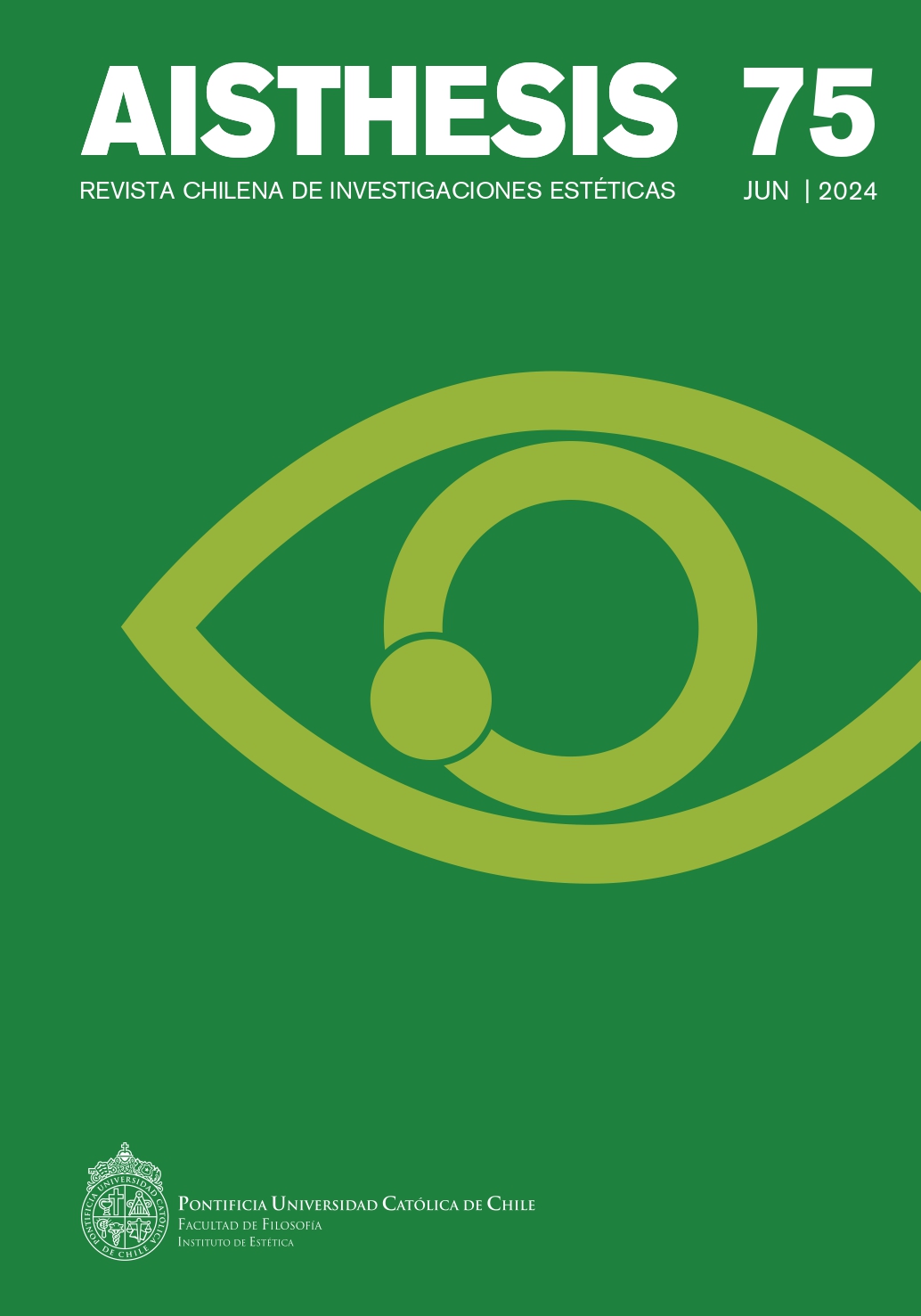Becoming Animal in Documentary Film The Cave of Forgotten Dreams by Werner Herzog
Main Article Content
Abstract
How does film problematize the human-animal relationship? This article develops this question by analysing the film Cave of Forgotten Dreams (2010). In this film, German filmmaker Werner Herzog (1942-) delves into one of the most fascinating discoveries of all time: the art of the Chauvet Cave (30.000 to 32.000 BP). The text proposes that, through the physical involvement of the viewing public, the focus on affect and the intertwining of reality and fiction, the documentary develops a field of intensities that allows us to glimpse a becoming animal through film.
Downloads
Article Details

This work is licensed under a Creative Commons Attribution-NonCommercial-ShareAlike 4.0 International License.
All contents of this electronic edition are distributed under the Creative Commons license of "Attribución-shareAlike 4.0 Internacional" (CC-BY-SA). Any total or partial reproduction of the material must mention its origin.
The rights of academic works published in this publication belong to their authors., who grant to AISTHESIS: Revista Chilena de Investigaciones Estéticas the license for its use. The management of the permits and the authorization of the publication of the images (or of any material) that contains copyright and its consequent rights of reproduction in this publication is the sole responsibility of the authors of the articles
References
Referencias
Abram, David. Devenir animal. Una cosmología terrestre. Sigilo, 2021.
––.«Lecturas: animales ¿Dónde empieza y termina lo humano?» La Nación, 30 de octubre de 2021. https://www.lanacion.com.ar/ideas/lecturas-animales-donde-empieza-y-termina-lo-humano-nid30102021/
––. «David Abram en primera persona». Festival Internacional de Literatura, Buenos Aires, Argentina, 2022. https://www.filba.org.ar/filba-internacional/festival-internacional-2022_120/programa/david-abram-en-primera-persona-virtual_1521
Bailly, Jean-Christophe. Le versant animal. Bayard, 2018.
Bataille, Georges. Lascaux or the Birth of Art. Skira, 1955.
Bennett, Jane. Vibrant matter: a political ecology of things. Duke University Press, 2010.
Berque, Agustin. «Lieu et authenticité». Cahiers de Géographie du Québec, nº 142, 2007, pp. 49-66.
Braidotti, Rosi. Lo posthumano, trad. Juan Carlos Gentile Vitale. Grijalbo, 2015 [2013].
Bruzzi, Stella. New Documentary. 2nd Edition. Routledge, 2006.
Deleuze, Gilles. L’image-mouvement. Cinema 1. Éditions de Minuit, 1983.
––. L’image-temps. Cinema 2. Éditions de Minuit, 1985.
––. Niestzsche y la filosofía. Anagrama, 2015.
Deleuze, Gilles y Félix Guattari. Kafka. Pour une littérature mineure. Les Éditions de Minuit, 1975.
––. Mille plateau. Capitalisme et Squizophrénie. Les Éditions de Minuit, 1998 [1984].
––. What is philosophy? Columbia University Press, 1996 [1994].
Descola, Philippe. Beyond nature and culture, trad, J. Lloyd. University of Chicago Press, 2013.
Escobar, Arturo. El final del salvaje: Naturaleza, cultura y política en la antropología contemporánea. CEREC. Instituto Colombiano de Antropología, 1999.
Fotogramas. «Herzog explora la cueva de los sueños olvidados», 2012. Recuperado de https://www.fotogramas.es/noticias-cine/a480112/werner-herzog-explora-la-cueva-de-los-suenos-olvidados/.
Gabrea, Radu. Werner Herzog et la Mystique Rhénane. L’Age de L’Homme, 1986.
Haraway, Donna. J. Staying with the trouble: making kin in the Chthulucene. Duke University Press, 2016.
Herzog, Werner. On the Absolute, the Sublime, and Ecstatic Truth, 1990. Recuperado de: https://www.bu.edu/arion/files/2010/03/Herzog.pdf
––. Minnesota Declaration, 1999. Recuperado de: https://designmanifestos.org/werner-herzog-the-minnesota-declaration/
––. The Cave of Forgotten Dreams. Producida por Erik Nelson et al., 2010. Recuperado de https://www.springfieldspringfield.co.uk/movie_script.php?movie=cave-of-forgotten-dreams.
Ingold, Tim. «Building, Dwelling, Living. How Animals and People Make themselves at Home in the World». Shifting Context. Transformations in Anthropological Knowledge, ed. Marilyn Strathern. Routledge, 1995, pp. 57-90.
Johnson, Christopher. «Science in Three Dimensions: Werner Herzog’s Cave of Forgotten Dreams». The Modern Language Review, nº 109, vol. 4, 2014, pp. 915-930. https://doi.org/10.5699/modelangrevi.109.4.0915
Kingler, Barbara. «Cave of Forgotten Dreams: Meditations on 3D». Film Quarterly, nº 65, vol. 3, 2012, pp. 38-43. https://doi.org/10.1525/FQ.2012.65.3.38
Kover, T. R. y K. U. Leuven. «The Beastly Familiarity of Wild Alterity». Ethical Perspectives, vol. 14, nº 4, 2007, pp. 431-456. https://doi.org/10.2143/EP.14.4.2028826
Mickey, Sam. «David Abram. Becoming Animal: An Earthly Cosmology». California Institute of Integral Studies. Pantheon Books, 2010. Book Reviews / Worldviews, nº 16, 2012, pp. 99-109.
––. Introduction to Documentary. Indiana University Press, 2001.
Rabinowitz, Paul. «Wreckage upon Wreckage: History, Documentary and the Ruins of Memory». History and Theory, vol. 32, nº 2, 1993, pp. 119-137.
Santos, Milton. La naturaleza del espacio. Técnica y tiempo. Razón y emoción. Ariel, 2000.
Serge, Margarita. El revés de la Nación. Territorios salvajes, fronteras y tierras de nadie 2ª ed. Ediciones Uniandes, 2011.
Poch, Chantal. «Spirit and Matter. Andrei Rublev (Andrei Tarkovski, 1966) and Heart of Glass (Werner Herzog, 1976)». L’ATALANTE, nº 29, pp. 165-175, 2020.
Wigley, Samuel. «Out of the Darkness: Werner Herzog’s Cave of Forgotten Dreams». Werner Herzog Interviews. Conversations with Filmmakers Series, ed. Eric Ames. University Press of Mississippi, 2011.
Obras audiovisuales
Land of Silence and Darkness (Land des Schweigens und der Dunkelheit). Documental escrito, dirigido y producido por Werner Herzog, 1971.
Aguirre. The Wrath of God (Aguirre, der Zorn Gottes). Filme de épico-histórico dirigido por Werner Herzog, producido por Filmproduktion y Hessischer Rundfunk,1972.
Heart of Glass (Herz aus Glass). Filme de ficción escrito y dirigido por Werner Herzog, producido por Werner Herzog y Filmproduktion, 1976.
Fitzcarraldo. Filme de ficción escrito y dirigido por Werner Herzog, producido por Werner Herzog, Filmproduktion y Wildlife Films Perú, 1982.
Burden of Dreams. Documental sobre la realización de la película Fitzcarraldo de Werner Herzog dirigido por Les Blanc, 1982.
Grizzly Man. Documental sobre el ecologista Timothy Treadwell, dirigido por Werner Herzog, producida por Lions Gate Films, 2005.
Encounters at the End of the World. Documental sobre la Antártica, dirigido por Werner Herzog, producido por Erik Nelson, Henry Kaiser, Phil Fairclough, Dave Harding, Julian Hobbs y Andrea Meditch 2007.
The Cave of Forgotten Dreams. Documental sobre las pinturas rupestres de Chauvet, Francia, dirigido por Werner Herzog, producido por Erik Nelson y Adrienne Ciuffo, 2010.
